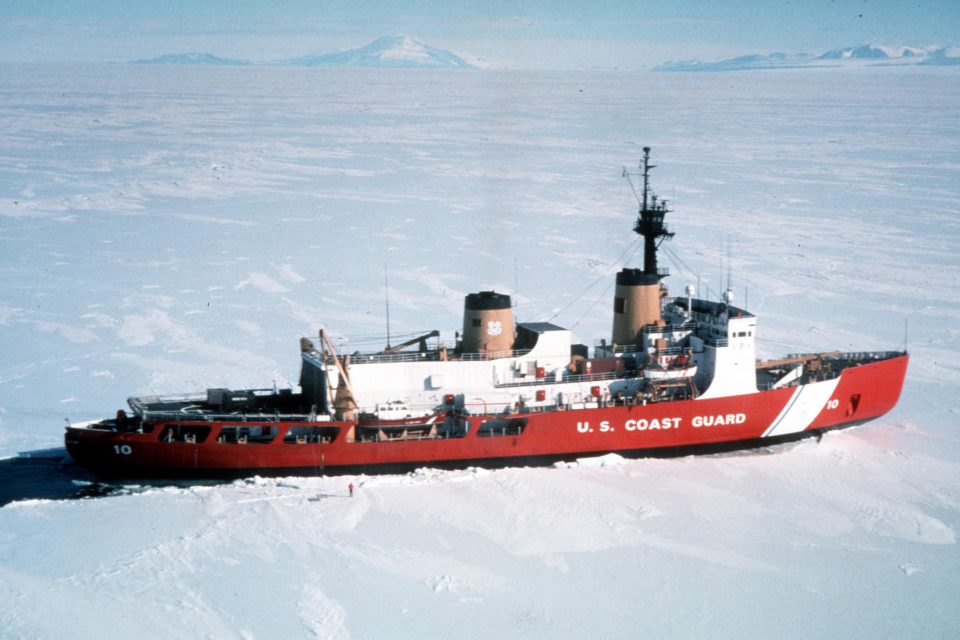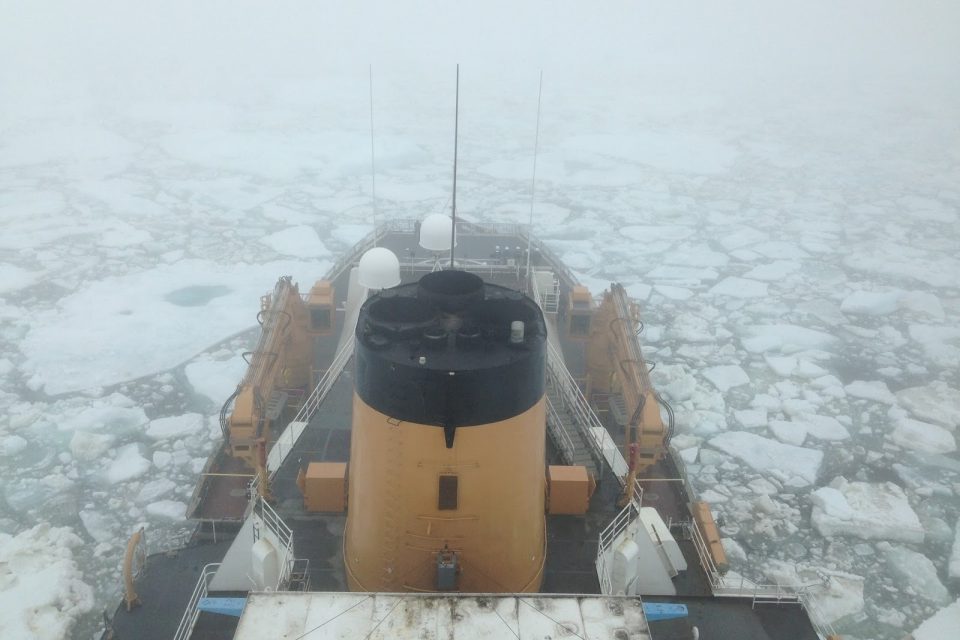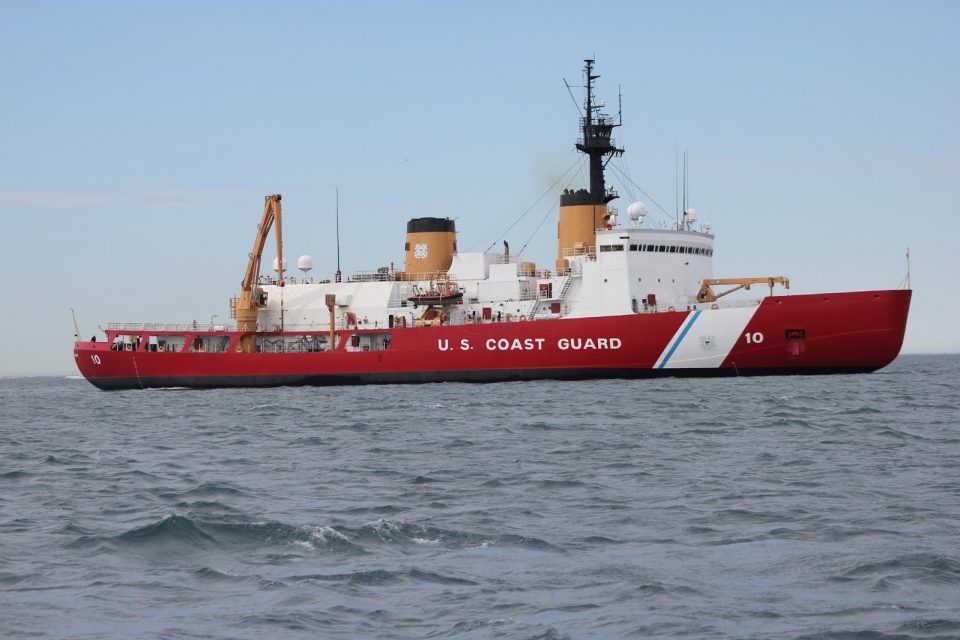2016-01-16 By Scott Truver
It became commonplace during the Cold War for the President, confronted with a crisis somewhere in the world to ask, “Where are the aircraft carriers?”
Given climate change and other trends and dynamics, some future President, confronting a crisis in the Arctic or Antarctic, will almost certainly ask, “Where are the icebreakers?”
Unless we act soon, the response most assuredly will be, “What icebreakers?”
“We are clearly behind in the Arctic,” retired Coast Guard Commandant Adm. Robert Papp told NBC News in a September 2015 interview.
Now serving as America’s Special Representative to the Arctic Council, he noted, “We don’t have enough ships in the Arctic…. We have only one heavy icebreaker that’s fully operational, the Polar Star [WAGB-10], which is approaching 40 years of age, old for any ship.”
To build a new-design heavy icebreaker would cost about a billion dollars, “but that’s because we haven’t built a heavy icebreaker in about four decades and it requires special skills,”
Papp acknowledged. “The Finns tell me that they can build three icebreakers for a billion dollars, but they’ve been building icebreakers for many years.”
In an era of squeaky-tight fiscal resources, finding the money to build the next icebreaker will be difficult, to say the least.
Part of that pessimism results from bureaucratic myopia and inertia.
An Aging “Fleet”
Today, the Coast Guard has only two icebreakers.
There is the heavy icebreaker the Polar Star earmarked for Operation Deep Freeze Antarctic breakout, scientific research and resupply operations.
And there is the medium icebreaker Healy (WAGB-20), for the National Science Foundation’s Arctic scientific research––available for intermittent presence year-round in the high latitudes.
Another heavy icebreaker, the Polar Sea (WAGB-11), remains in caretaker status, with the Coast Guard occasionally considering how much it would cost and how much service-life it would provide if the resources could be found to bring her back to operating status.
The answers usually have been, “too much and not enough.”
The Polar Star was commissioned in January 1976; the Polar Sea, in February 1978 (and still laid up); and the Healy, in August 2000. Certified as a “medium” icebreaker, Healy can conduct continuous passage in ice up to three feet thick, and backing and ramming in ice up to seven feet thick.
A “heavy” icebreaker, Polar Star can conduct continuous passage in ice up to six feet thick, and backing and ramming in ice up to 21 feet thick.
These three ships pale in comparison with Russia’s 40 icebreakers in 2015––several of which are nuclear powered––and Moscow already has the world’s most powerful icebreakers and is building more.
In addition to the Polar Star and Healy, the Coast Guard operates the Great Lakes icebreaker, Mackinaw (WLBB-30), and a handful of ice-strengthened buoy tenders and tugs.
Requirements Go Begging
In September 2011, the Coast Guard submitted its High Latitude Region Mission Analysis Report to Congress.
The report cited a significant polar icebreaking capability gap that will continue to prevent the Coast Guard from conducting its critical missions in the Polar regions. The report concluded (emphasis in the original):
The Coast Guard requires three heavy and three medium icebreakers to fulfill its statutory missions.
These icebreakers are necessary to (1) satisfy Arctic winter and transition season demands, and (2) provide sufficient capacity to also execute summer missions. Single-crewed icebreakers have sufficient capacity for all current and expected statutory missions.
Multiple crewing provides no advantage because the number of icebreakers required is driven by winter and shoulder season requirements.
Future use of multiple or augmented crews could provide additional capacity needed to absorb mission growth…. Consistent with current practice, these icebreakers are single-crewed and homeported in Seattle, Washington.
Two years later, the Department of Homeland Security approved a mission need statement for the polar icebreaker recapitalization project for a fleet of up to three heavy and three medium ships to meet mission demands in the high latitudes.
On 20 June 2014, the Coast Guard announced:
The U.S. Coast Guard’s Polar Icebreaker acquisition project achieved the next acquisition milestone on June 13, 2014, with approval to enter the Analyze/ Select phase of the Department of Homeland Security acquisition lifecycle.
This action validates the need for continued icebreaker capabilities and allows the project to move forward to the next acquisition phase.
During the Analyze/Select Phase, the Coast Guard will develop operational requirements for a future polar icebreaker, identify resources required to maintain the asset through its lifecycle and assess potential alternatives capable of meeting polar icebreaking mission requirements.
The capabilities needed to address polar requirements do not come cheap, with the lead heavy icebreaker coming in at least $1 billion. Given the myriad challenges to deliver first-of-class ships on time and budget, that figure might well prove optimistic.
Nevertheless, if the lead and five follow-on heavy and medium icebreakers were put under contract at a single yard, there could well be economic efficiencies to be wrung out of the designs and production.
National Assets
There have been proposals for the Navy or the National Science Foundation to help pay for the icebreakers.
Sen. Lisa Murkowski (R-Alaska), who has been the Congress’ champion for a modern icebreaking fleet, wants a Navy and Coast Guard partnership to fund the vessels. “Do you know how many naval ships we are building? A lot,” she told Politico. “Do you know how many icebreakers we are building? None.”
In May 2015, Murkowski and Sen. Maria Cantwell (D-Washington) introduced the Icebreaker Recapitalization Act, which would authorize the U.S. Navy to construct up to six heavy icebreakers that would be designed and operated by the Coast Guard (emphasis in the original):
Today we take a strong, bipartisan step towards investing in the Coast Guard Arctic infrastructure and operations—by calling for serious investments in our polar icebreaking fleet.” Cantwell said.
“Our legislation makes sure that the United States is able to protect our interests in the Arctic, and it gives the men and women in the Coast Guard and Navy the tools they need to do their jobs. Icebreakers protect America’s Arctic interests and support Washington state shipbuilding jobs.
As an Arctic nation, America must be a global leader towards an Arctic future as this dynamic region opens up to new opportunities; by contrast, countries from Russia to Canada to China to even India see the worth and importance in investing in icebreakers,” said Senator Lisa Murkowski, Chair of the U.S. Senate Arctic Caucus.
“From a military perspective, this is an imperative; from an economic development viewpoint, it is a down payment on an Arctic future, and as a scientific research opportunity, it opens up a new world of knowledge.
Good words, to be sure, but the bill died quietly after being referred to the Armed Services Committee.
Assuming a decision were made to start the design and construction of the first of the six icebreakers outlined in Coast Guard plans in fiscal year 2020, it will be 10 years — if not longer — before the first ship sails. U.S. law requires Coast Guard vessels to be constructed in U.S. shipyards.
The last U.S. yard to construct an icebreaker –– the Healy –– was Avondale Industries (New Orleans, Louisiana).
That was closed by parent company Huntington Ingalls Industries.
That said, Ingalls Shipbuilding (Pascagoula, Mississippi) retains unique engineering and production capabilities to build icebreakers.
The yard that built the Polar Star and Polar Sea, Lockheed Shipbuilding (Seattle, Washington), closed in 1988.
Semper Hopeful
The Obama Administration in September 2015 proposed accelerating the “…acquisition of a replacement heavy icebreaker to 2020 from 2022, begin planning for construction of additional icebreakers, and call on Congress to work with the Administration to provide sufficient resources to fund these critical investments.”
“These heavy icebreakers will ensure that the United States can meet our national interests, protect and manage our natural resources, and strengthen our international, state, local, and tribal relationships.”
It will be interesting to see if the White House will enthusiastically support this much-needed and long-overdue national asset, or “kick the can” to the next administration.
So, “Where are the icebreakers?” a future President will ask.
We need to get our acts together, soon, so a future Commandant’s response can be, “Where they’re needed.”
Scott Truver has supported the Coast Guard since 1979 in a broad spectrum of strategy, policy, requirements, programs, and operations projects. He is director, TeamBlue National Security Programs, Gryphon Technologies LC.
This piece first appeared on Breaking Defense.
Editor’s Note: It is not just the icebreakers. The serious shortfall in building the new National Security Cutters is crucial as well. Ice-hardened cutters have been envisaged as well for the fleet to work along side the icebreakers.
Arctic operations require not only special equipment, but special skill sets as well.
We have interviewed both Danish and US mariners with significant Arctic experience, and their views can be seen here:
http://sldinfo.wpstage.net/ending-reluctance/
http://sldinfo.wpstage.net/operating-in-the-arctic-resourcing-for-the-21st-century/
We have provided assessments of the evolving role of the Arctic in the new Pacific situation as well as in Russian and Nordic calculus’s as well.
We have provided analyses as well at how best to prepare for the emerging situation.
http://sldinfo.wpstage.net/preparing-for-an-arctic-future-general-jacoby-looks-at-the-challenges/
http://sldinfo.wpstage.net/shaping-arctic-defense-leveraging-the-grid/
http://sldinfo.wpstage.net/china-coming-into-the-arctic-shaping-a-flanking-strategy/
http://sldinfo.wpstage.net/a-danish-perspective-on-the-challenge-of-arctic-security/
http://sldinfo.wpstage.net/alaska-the-arctic-and-crafting-strategic-depth/
http://sldinfo.wpstage.net/admiral-wang-on-baltic-and-arctic-defense-a-danish-perspective/
http://sldinfo.wpstage.net/greenland-and-the-arctic-the-emergence-of-a-new-sovereign-state/
http://sldinfo.wpstage.net/outgoing-uscg-commandant-reviews-the-challenges-facing-the-uscg/
http://sldinfo.wpstage.net/the-bering-strait-choke-point-of-the-future/
The slideshow above shows Coast Guard Cutter Polar Star transits through the water accomplishing the Coast Guard missions in the summer of 2013.
The Polar Star is one of the largest ships within the Coast Guard measuring at 399 feet long.
Polar Star is specifically designed for open-water icebreaking with reinforced hull and a round hull to ride up on the ice.
The third photo shows the ship operating in Antarctica.
3/26/14
Credit: USCG
According to a story in The Seattle Times published on 1/14/14:
She’s not the biggest ship around, but she’s the baddest of her kind, and now the Seattle-based Polar Star, the Coast Guard’s only active heavy-duty polar icebreaker, is heading to Antarctica to rescue two other icebreakers stuck in pack ice.
The Chinese icebreaker Xue Long, which helped evacuate 52 passengers from the trapped Russian ship Akademik Shokalskiy last week, is now feared to be blocked by ice, as well.
The Polar Star, a 399-foot powerhouse whose engines can deliver 75,000 horsepower, recently completed a $90 million, three-year overhaul, according to the Coast Guard. With its specially designed hull, it can continuously break 6 feet of ice while moving at three knots, and break through a two-story wall of ice by backing up and ramming.
The icebreaker left Sydney, Australia, Saturday morning Pacific Time and is expected to be at the scene of the icebound ships — about 1,500 miles south of Hobart, Tasmania — about Jan. 12, said Chief Warrant Officer Allyson Conroy, of the U.S. Coast Guard.
The Polar Star, which finished its tests in Arctic ice in July, has been traveling toward Antarctica since early last month en route to its regular job — resupplying and refueling research stations there managed by the National Science Foundation.
On Friday, the Australian Maritime Safety Authority, which is coordinating rescue operations, asked the U.S. Coast Guard for assistance after the Xue Long got stuck; the Russian and Chinese governments have also requested U.S. assistance, Conroy said.
“Our highest priority is safety of life at sea, which is why we are assisting in breaking a navigational path for both of these vessels,” said Vice Adm. Paul F. Zukunft, Coast Guard Pacific Area Commander, in a statement. “We are always ready and duty bound to render assistance in one of the most remote and harsh environments on the face of the globe.”
Retired Coast Guard Rear Adm. Jeffrey Garrett, former commander of Polar Sea, Polar Star’s sister ship, and former district commander in Seattle, said the Polar Star is a much stronger icebreaker than either of the two stuck ships.
Its 75,000 horsepower far outguns the Russian ship, with about 3,000 horsepower, or the Chinese icebreaker, which, although larger, has less than 18,000 horsepower, he said.
Polar Star is also more maneuverable than the single-propeller Chinese ship, he said, with three shafts and three propellers, and with both diesel and “high-end, heavy-duty” gas turbine engines.
The ship’s hull is specially designed for icebreaking, both in terms of its shape, special steel cladding, and the ship’s frame underneath, Garrett said.
“More power, better maneuverability — the chances of the Star getting stuck are much smaller,” said Garrett, who most recently has served as an ice pilot on Antarctic cruises.
Senators from Washington and Alaska are seeking to construct as many as four new heavy-duty icebreakers, a project with a price tag of $850 million or more per vessel. Polar Star and Polar Sea were built in the 1970s by Lockheed Shipbuilding in Seattle.




